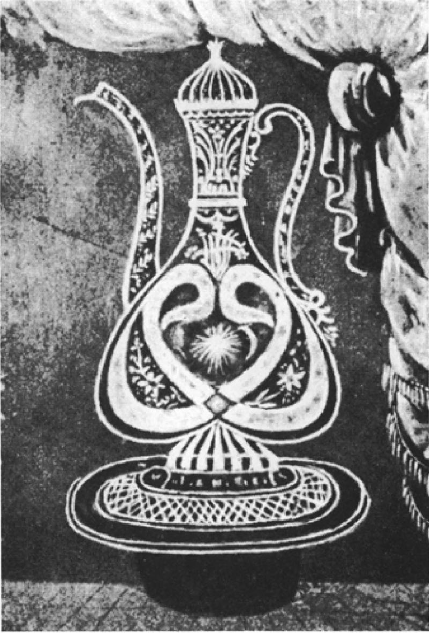Question # 387: What is the significance of letter ‘waw’ in the Turkish Culture?
bismi-llahi r-raḥmani r-raḥīm,
Assalamu ‘laikum warahmatullahi wabarakatuh,
All praise and thanks are due to Allah (سبحانه و تعالى), and peace and blessings be upon His Messenger (صلى الله عليه و سلم).
Dear questioner,
First of all, we implore Allah (سبحانه و تعالى) to help us serve His cause and render our work for His sake.
Shorter Answer: ‘Waw’ is the sixth letter of the Northwest Semitic family of scripts, including Phoenician, Aramaic, Hebrew, Syriac, and Arabic (“sixth” in abjadi order; it is 27th in modern Arabic order). According to Sufism, each letter of the Arabic alphabet is assigned a relationship between the divine realm and the human world and the letter ‘waw’, which is equal to number six (6), refers to al-‘aql bil-idafah (lntellect in relation to what is below it). Further, letter ‘waw’ possesses this number six because the Prophet (صلى الله عليه و سلم) extended the length of vowels by as much as six degrees. Furthermore, in the Islamic mystical tradition, the number 66 corresponds to the numerical value of the word ‘Allah’. Such an interpretation appears in Turkish calligraphy, where the letter ‘waw’ with its numerical value of 6 is often doubled. This motif is used in decorative inscriptions from the early eighteenth century on and can suggest either the number 66 (i.e., Allah) or 6 + 6 = 12, which would be an allusion to the 12 imams of Shi’ahs (see image below in the Long Answer).
Note: The answer given here is in no way supporting/endorsing the deviated beliefs of Sufism or Shi’ism; the research was conducted merely to answer the question received.
Long Answer: ‘Waw’ is the sixth letter of the Northwest Semitic family of scripts, including Phoenician, Aramaic, Hebrew, Syriac, and Arabic (“sixth” in abjadi order; it is 27th in modern Arabic order). (boutiqueottoman.com) [According to Sufism, there are] vowel sounds and vibratory effects in reciting the Holy Qur’an. But each letter of the Arabic alphabet is assigned a relationship between the divine realm and the human world. [They list a number of Arabic alphabets showing] …the correspondence between each letter and the regions of the hierarchy of the universe. As for letter ‘waw’, it equals number six (6), referring to al-‘aql bil-idafah (lntellect in relation to what is below it) (‘The Book of Sufi Healing’ by Hakim Moinuddin Chishti)
[Further, according to Sufism, to explain the mystery of number six (6),] the soft letters (huruf al-madd wa’l-lin), namely alif, waw and ya. Each one of these possesses this number six because the Prophet (صلى الله عليه و سلم) extended the length of vowels by as much as six degrees. (‘Basic Texts of Islamic Mysticism – Pure Gold from the Words of Sayyidi ‘Abd al-‘Aziz al-Dabbagh’ by Ahmad b. al-Mubarak al-Lamati)
[Furthermore,] in the Islamic mystical tradition, [the number 66] corresponds to the numerical value of the word ‘Allah’. Hence, Turkish Sufis would explain the predominance of the tulip in Turkish art, as well as the emblem of Islam, the crescent moon, by the fact that the names of these 2 motifs, lalah and hilal respectively, consist of the same letters and have the same numerical value as ‘Allah’.
Sixty-six can also be seen as a duplication of 6, or as a number in the second power (as is the case with many similar numbers – 44, 77, etc.). From a purely visual vantage point, 66 is 2 times 6, or 6 times 6. Interestingly, just such an interpretation appears in Turkish calligraphy, where the letter ‘waw’ with its numerical value of 6 is often doubled. This motif is used in decorative inscriptions from the early eighteenth century on and can suggest either the number 66 (i.e., Allah) or 6 + 6 = 12, which would be an allusion to the 12 imams of Shi’ite Islam.
The doubled Arabic letter ‘w’, which has the numerical value of 6. It may be interpreted, then, as 6 and 6 = 66, and thus pointing to the 66 of ‘Allah’. Alternately, it could be read as 6 + 6 = 12, which would then allude to the 12 imams of Shi’ite Islam. The ‘w’ and the double ‘w’ have been used in Turkey for calligrams since the early eighteenth century. (‘The Mystery of Numbers’ by Annemarie Schimmel)
Allahu A’lam (Allah (سبحانه و تعالى) knows best) and all Perfections belong to Allah, and all mistakes belong to me alone. May Allah (سبحانه و تعالى) forgive me, Ameen.
Wassalaam



